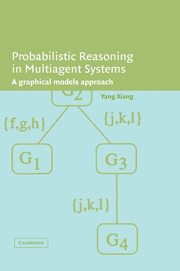Book contents
- Frontmatter
- Contents
- Preface
- 1 Introduction
- 2 Bayesian Networks
- 3 Belief Updating and Cluster Graphs
- 4 Junction Tree Representation
- 5 Belief Updating with Junction Trees
- 6 Multiply Sectioned Bayesian Networks
- 7 Linked Junction Forests
- 8 Distributed Multiagent Inference
- 9 Model Construction and Verification
- 10 Looking into the Future
- Bibliography
- Index
7 - Linked Junction Forests
Published online by Cambridge University Press: 31 August 2009
- Frontmatter
- Contents
- Preface
- 1 Introduction
- 2 Bayesian Networks
- 3 Belief Updating and Cluster Graphs
- 4 Junction Tree Representation
- 5 Belief Updating with Junction Trees
- 6 Multiply Sectioned Bayesian Networks
- 7 Linked Junction Forests
- 8 Distributed Multiagent Inference
- 9 Model Construction and Verification
- 10 Looking into the Future
- Bibliography
- Index
Summary
In Chapter 6, MSBNs were derived as the knowledge representation for multiagent uncertain reasoning under the five basic assumptions. As in the case of single-agent BNs, we want agents organized into an MSBN to perform exact inference effectively by concise message passing. Chapter 4 discussed converting or compiling a multiply connected BN into a junction tree model to perform belief updating by message passing. Because each subnet in an MSBN is multiply connected in general, a similar compilation is needed to perform belief updating in an MSBN by message passing. In this chapter, we present the issues and algorithms for the structural compilation of an MSBN. The outcome of the compilation is an alternative dependence structure called a linked junction forest. Most steps involved in compiling an MSBN are somewhat parallel to those used in compiling a BN such as moralization, triangulation, and junction tree construction, although additional issues must be dealt with.
The motivations for distributed compilation are discussed in Section 7.2. Section 7.3 presents algorithms for multiagent distributive compilation of the MSBN structure into its moral graph structure. Sections 7.4 and 7.5 introduce an alternative representation of the agent interface called a linkage tree, which is used to support concise interagent message passing. The need to construct linkage trees imposes additional constraints when the moral graph structure is triangulated into the chordal graph structure. Section 7.6 develops algorithms for multiagent distributive triangulation subject to these constraints.
- Type
- Chapter
- Information
- Probabilistic Reasoning in Multiagent SystemsA Graphical Models Approach, pp. 142 - 181Publisher: Cambridge University PressPrint publication year: 2002

